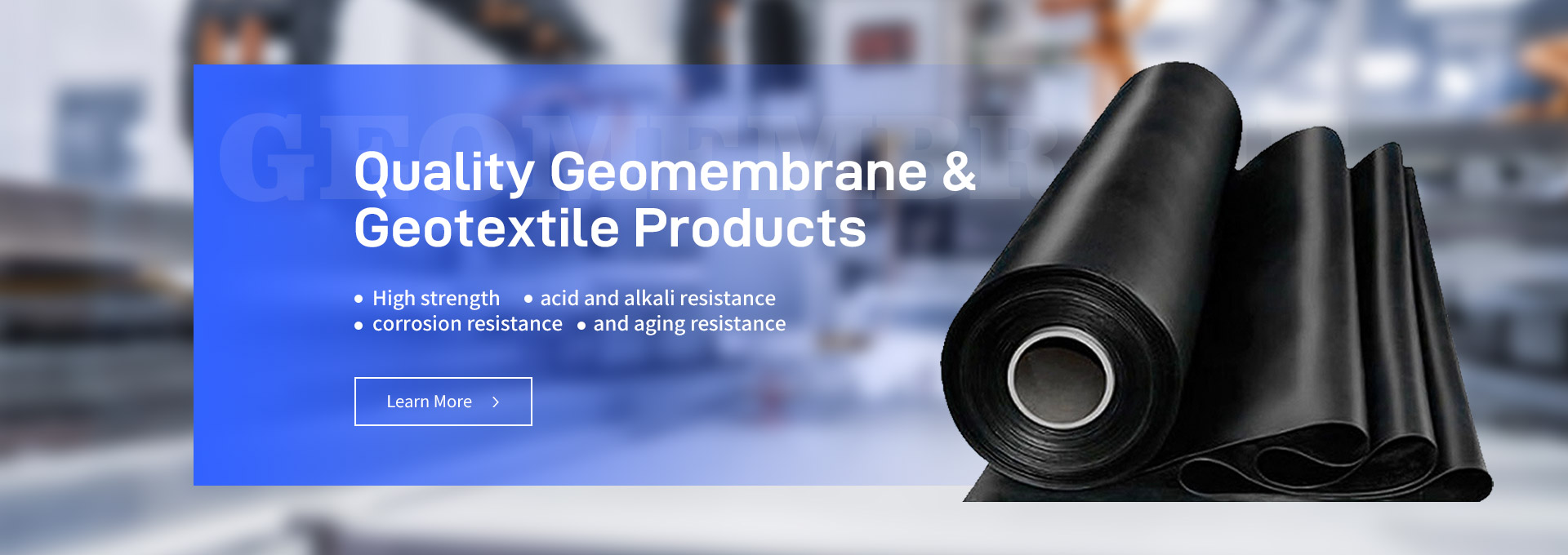In modern civil engineering and environmental protection, geomembranes are widely used in fields like water conservancy, environmental protection, mining, and transportation. As an important engineering material, geomembranes come in various types, with composite geomembrane and single-sided geomembrane being two common products. While they may appear similar at first glance, they differ significantly in structure, function, and applications, making it crucial to understand these differences when selecting the right material for your project.

What is a Composite Geomembrane?
A composite geomembrane is a geosynthetic material made by bonding two or more different materials together. Typically, a composite geomembrane consists of a layer of geomembrane material such as high-density polyethylene (HDPE) or low-density polyethylene (LDPE), combined with a layer or more of geotextile materials like nonwoven geotextile or geogrids. This combination gives the composite geomembrane enhanced performance in terms of water-proofing, separation, and reinforcement.
Because of its multi-layer structure, the composite geomembrane combines the impermeability of the membrane with the strength, tensile properties, and soil separation abilities of geotextiles and geogrids. This makes it ideal for more complex engineering projects, especially where high-performance water-proofing is required.
What is a Single-Sided Geomembrane?
A single-sided geomembrane (also known as a "simple geomembrane") consists of a single layer of membrane material, typically made from high-density polyethylene (HDPE), low-density polyethylene (LDPE), or polyvinyl chloride (PVC). Unlike composite geomembranes, single-sided geomembranes are simpler in design, focusing solely on impermeability.
While single-sided geomembranes offer excellent impermeability, their lack of additional reinforcement layers results in lower tensile strength and puncture resistance compared to composite geomembrane products. As such, single-sided geomembranes are often used in projects where the requirements are less demanding in terms of structural integrity.
Key Differences Between Composite Geomembrane and Single-Sided Geomembrane
1. Structure
The most significant difference between a composite geomembrane and a single-sided geomembrane lies in their structure. Composite geomembrane has at least two layers: one is the membrane layer, and the other is a geotextile or geogrid layer that strengthens the membrane and provides added durability. In contrast, a single-sided geomembrane has only one layer of membrane material, making it simpler but less durable.
2. Performance Differences
Impermeability: Both composite geomembranes and single-sided geomembranes excel in impermeability. Due to the nature of the membrane materials, both types effectively prevent water or contaminants from passing through. However, composite geomembrane offers the additional benefit of being stronger and more durable under pressure.
Tensile Strength: One key advantage of composite geomembrane is its superior tensile strength, thanks to the reinforcing layer of geotextile or geogrid. This added strength makes it ideal for applications that involve higher soil loads or difficult environmental conditions. Single-sided geomembranes, with no added reinforcement, are less capable of withstanding tensile stresses and are better suited for less demanding projects.
Puncture Resistance: Composite geomembrane also offers better puncture resistance compared to single-sided geomembranes. The geotextile or geogrid layers provide additional protection against sharp objects in the soil, preventing damage to the membrane. Single-sided geomembranes, being more fragile, may require additional layers or protection in challenging conditions.
Separation and Reinforcement: Composite geomembranes provide not only waterproofing but also separation between different soil layers, preventing the mixing of materials and ensuring the integrity of the structure. Single-sided geomembranes lack this separation feature, making them less versatile in certain applications.
3. Applications
Due to its enhanced strength and multi-functional properties, composite geomembrane is commonly used in complex engineering projects, such as:
l Landfill liners
l Mining tailings dams
l Water reservoirs
l Hydraulic engineering
l Underground structures
l Road construction
On the other hand, single-sided geomembranes are typically used in simpler applications such as small water ponds, artificial lakes, and reservoirs. Their affordability and ease of use make them suitable for less demanding tasks.
4. Cost Differences
Composite geomembranes are generally more expensive than single-sided geomembranes due to their multi-layer structure and superior performance. While the upfront cost may be higher, the longevity and durability of composite geomembrane can make it more cost-effective in the long run, particularly for large-scale or complex projects.
Single-sided geomembranes, being simpler to manufacture, are more affordable and can be a good choice for smaller projects with fewer structural demands. However, for projects with specific performance requirements, composite geomembrane may be a more suitable and long-lasting solution.
5. Installation and Maintenance
Both composite geomembranes and single-sided geomembranes require professional installation to ensure optimal performance. However, because of its additional layers, the installation of a composite geomembrane requires more attention to detail, especially in terms of the joining process and ensuring proper sealing between layers.
When it comes to maintenance, composite geomembranes typically have a lower long-term maintenance cost due to their durability and strength. Single-sided geomembranes, on the other hand, may require more frequent inspections and maintenance, especially in areas subject to mechanical stress or puncture.
How Much is Geomembrane?
When evaluating costs, it’s important to consider the price of a composite geomembrane versus a single-sided geomembrane. While the latter may be cheaper in the short term, the additional benefits offered by a composite geomembrane, such as increased longevity and resistance to environmental stress, may justify the initial higher price, especially for larger projects.
If you’re wondering, "How much is geomembrane?", the cost can vary depending on factors like material type, thickness, and the manufacturer. It’s essential to consult with a reliable geomembrane manufacturer to get accurate pricing based on your specific needs and requirements.
Conclusion
Both composite geomembranes and single-sided geomembranes have their unique advantages and suitable applications. Composite geomembrane excels in projects requiring high strength, durability, and multi-functional performance, while single-sided geomembranes are ideal for simpler, less demanding applications where budget is a concern.
By considering the specific needs of your project and understanding the differences between these two types of geomembranes, you can make a more informed decision on which product will provide the best value and performance. If you need further assistance in selecting the right geomembrane, feel free to contact a trusted geomembrane manufacturer for professional advice and guidance.

